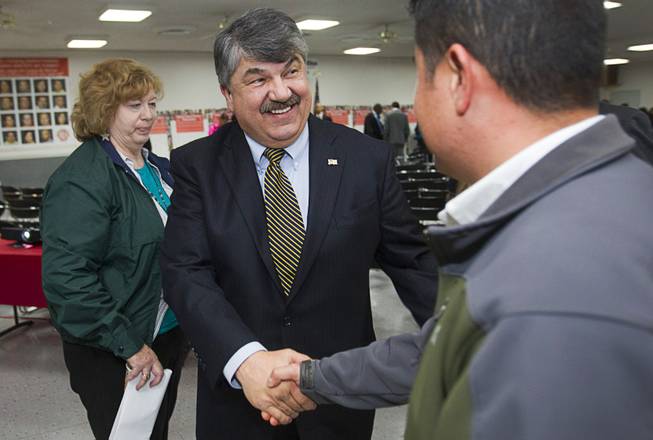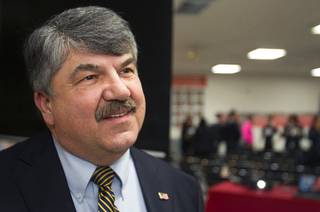
AFL-CIO President Richard Trumka, center, greets union members following a gathering of union leaders, working families and community partners at the Culinary Workers Local 226 union hall Tuesday, Jan. 29, 2013.
Thursday, Feb. 7, 2013 | 2 a.m.
Sun coverage
When President Barack Obama came to Las Vegas last week to push for reform of the immigration system, several leaders from the largest unions in the country were in attendance, including those that helped scuttle immigration reform efforts in 2007.
After the 25-minute speech in which Obama outlined four key principles of his plan, organizations from every side of the issue released statements.
“President Obama's plan offers nothing to American workers except the certainty of even greater competition for scarce jobs and further suppression of their wages,” Dan Stein, president of the Federation of American Immigration Reform, a restrictionist group that advocates for a focus on border security and strict limits on immigrants, said in a release.
It was the kind of statement that could have come from the AFL-CIO in the early 1990s, but instead Richard Trumka, the AFL-CIO president, joined several other union representatives from around the country in Las Vegas at a rally after the speech supporting immigration reform.
“We are going to do a whole national campaign for comprehensive immigration reform, because the current system is what depresses wages,” Trumka said. “They can’t cheat people out of wages, and they can’t pay them half the wages. When they try to assert any of their rights (the employers) call in ICE, and they get deported. The new system will allow them to have the same rights as every other worker, and be paid properly. They’ll come out of the shadows and have full rights like other workers, and it will be good for America and good for our economy.”
On Thursday, the AFL-CIO is expected to announce further details of its campaign to support immigration reform. On Monday, Culinary Union Local 226 will stage an event at Cashman Field in which it will lay out local and national union efforts to bolster support for immigration reform.
A week after his speech, Obama met in Washington, D.C., with top union leaders including Trumka, Eliseo Medina of the Service Employees International Union, and Arturo Rodriguez of United Farm Workers. While the unions are publicly supporting the push for reform, the details of the final legislation will play a large role in final approval from labor organizations.
In 2007, as George W. Bush pushed an immigration reform proposal, the AFL-CIO and SEIU split, with the former siding against the program due to concerns that a touted guest-worker program would undercut unions and that the path to citizenship for existing undocumented immigrants was too difficult.
In 2009, the AFL-CIO and SEIU came together with other groups to announce a common set of principles for approaching immigration reform. The proposal specifically advocates for “improvement, not expansion, of temporary worker programs” and an “adjustment in status for the current undocumented population.”
Until the start of the millennium, the AFL-CIO openly opposed immigrants living and working in the country illegally. In 2000, the group’s executive council voted to endorse a new policy including a path to citizenship.
The shift occurred for a variety of reasons, labor analysts say, and is reflective of changing union membership levels and demographics. Figures from the Department of Labor released in January show union membership has fallen to its lowest point since the 1930s. Nationally, union membership fell by 400,000 from 2012 to 2013 and now stands at 14.4 million workers.
UNLV political scientist John Tuman says unions started to embrace immigrant workers, and immigration reform, in the late 1990s as union membership was declining due in large part to manufacturing moving first to states with less of a union presence, and then abroad.
“If labor was going to arrest the long-term trend of decline in unionization rates, they realized they had to focus their efforts on those parts of the economy where employment was growing and where there was the potential to unionize successfully,” Tuman said. “It turned our to be the service sector, where for a variety of reasons, the skill set and demands lent itself to immigrant labor.”
Culinary Union Local 226 is the largest union in Nevada, representing 60,000 workers, most in the service industry. It was unions like this, which have a higher percentage of immigrant and Hispanic workers, that helped lead unions toward endorsing immigration reform.
"The Culinary Union has always supported immigration reform. In 1997, we were the first union to negotiate immigration language into our collective-bargaining agreements. In 2003, workers went across the country in support of comprehensive reform on the immigrant freedom rides,” said Geoconda Arguello-Kline, secretary-treasurer for Local 226.
During the post-Obama speech rally Jan. 29 at the Culinary Union, United Auto Workers president Bob King credited the Culinary Union’s parent organization, Unite Here, for being pioneers.
“Unite Here was one of the very first unions out there on this issue pushing for immigration reform, pushing to change the AFL-CIO pushing for what we are now seeing today,” King said.
Even if the workers themselves were legally working in the United States, many new union members had family members or friends who were affected by the sputtering efforts for immigration reform. For the union to best use its political power, it has to be unified, Tuman said, so it was in union management’s best interest to come in line with its rank-and-file.
“If it’s a cohesive union, the political payoff (of a political endorsement) is much higher,” Tuman said. “Unions want a membership base that will vote cohesively in a direction consistent with what leadership wants.”
Eventually, the pool of workers residing in the country illegally became so large as to reach a tipping point where bringing them into the legal system of employment was a better move for unions than trying to exclude them, Tuman said.
“If you have immigrant workers working without authorization, they face a certain amount of economic uncertainty,” Tuman said. “They lack labor rights, and from the standpoint of unions, there is some advantage to regularizing the status of immigrant workers to give them more leverage in the labor market. If you are a union engaged in collective bargaining and the average wages of non-union workers are higher, that puts you in a stronger position. An employer can implicitly use immigrant labor as a threat, arguing that if they can get the union decertified, they have a large pool of non-union workers who work at a much lower wage.”
At least one union has opposed the push for immigration reform, the National ICE Council, which represents approximately 7,000 Immigration and Customs Enforcement Agents, and is affiliated with the AFL-CIO.
"Respectfully, we see a lot of problems with the recently proposed reforms and we plan to exercise our rights as Americans to participate in the democratic process and voice those concerns publicly in the upcoming months; we hope to do so without groups like the AFL-CIO demonizing us for expressing a different opinion," Chris Crane, president of the National ICE Council, said in a statement released after Obama’s speech.
Trumka and the AFL-CIO declined to comment on the National ICE Council’s statement.
The AFL-CIO, whose affiliates represent 11 million workers, will certainly wait for the details of a final proposal before offering its approval.
“It really depends on what the legislation actually looks like,” said Audrey Singer, a senior fellow at the Brookings Institution who studies U.S. immigration policy. “I think the farm workers have their own issues that they are dealing with, and service workers have a different set of issues. It’s never going to be totally what everyone wants. All of us are waiting to see what will happen in the end.”
At the rally after Obama’ speech, Trumka expressed concerns over a Senate proposal suggesting citizenship would be tied to proof of work, arguing that would be problematic for day laborers, domestic workers and others.
The AFL-CIO president did seem prepared to wield the political power of a more united organization, however.
“I absolutely believe (comprehensive immigration reform) is going to get done this year and I believe anybody who stands in the way of it getting done this year in an unreasonable manner will pay a severe price at the polls in 2014,” Trumka said. “And if the Republican Party thinks and the House (of Representatives) thinks it will block immigration reform, they won’t be a majority in 2014.”


Join the Discussion:
Check this out for a full explanation of our conversion to the LiveFyre commenting system and instructions on how to sign up for an account.
Full comments policy